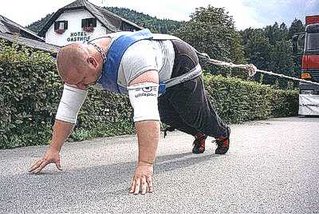You are what you train to be
You are what you train to be, I was taught that valuable lesson in a great class I had at UCSB in 1969, called Fundamentals of Conditioning, taught by Sherm Button. I have forgotten a lot of things from the class but I never have forgotten that lesson. If you train to be slow you will be slow, if you train to be fast you will be fast. Sounds simple and it is, but simplicity yields complexity. It is the simple axioms like this that are easy to forget. Frankly that is why when I look at some of the strength training programs that are the current rage, I wonder where common sense enters into the picture. Doing everything with chains, and bands and box squatting may make you measurably stronger, but does doing those slow movements all the time transfer? Based on what I learned a long time ago I don’t think so. Do those modes of training have a place? Sure they do, at certain phases, in small quantities to vary stimulus, but a steady diet will not improve explosive power. It all comes down to having a clear focus on what you are training for. Look carefully at the physical qualities demanded and train those qualities. You can get away with
 goofy stuff for a while, but eventually it will come back to haunt you. I remember a defensive back from here in
goofy stuff for a while, but eventually it will come back to haunt you. I remember a defensive back from here in 

7 Comments:
Vern,
Great post! This reminds me of a new DVD out on working out with Picnic Tables.
Does this mean in endurance sports you should only concentrate on race pace? I am throwing that out there as a "devil's advocate" type question :-)
Anonymous,
I dont think ONLY race pace but I do think that is EXACTLY the kind of thing athletes should do more of.
What is endurance? A hard core dictionary definition could be ability to cover distance. But if you are racing, that definition should be the ability to cover a given distance as quickly as possible.
To achieve that, I find resting better, and training in ways that help the athlete cover that given distance as quickly as possible yields the most consistent, and positive results.
That means minimal to no go slow for long periods training because the athletes goal is not to go slow for long periods (if it was they wouldnt be looking for coaching :)) - they want to go faster.
New (to me) athletes often will say things like "I can do my endurance rides (or other activity) at X pace and it is so easy, but when I race going just a little faster I totally fall apart" or "My legs feel destroyed late" etc. Subjectively I feel a big part of those outcomes is that many of them trained to go slow with lots of LSD "to build endurance and aerobic fitness" and they got just what they trained - to go slow.
For me, appropriate race pace (what event are we training for?) has evolved into a major component of training. So long as the global program is designed well, this has resulted in very positive results.
Just playing the devil for you :)
I have to appologize for the long winded reply here. This subject just gets me all fired up! Have a super day!
I would welcome some input on this. I am planning on coaching middle school track for the first time this spring. What is an effective way to work with distance runners generally? My thought are these: get them generally stronger, more coordinated, etc. the same way I do in my classes...but my thinking is getting them faster and then progressively increasing distance. The longest race is the mile by the way.
Good thinking or are there more effective ways?
the other thought is that my milers I am anticipating will be participating in other events that require speed and power.
I appreciate everyone's thoughts.
Well I'm a swimming coach and this subject is always interesting to me. What about developing threshold, VO2 level and then introducing race pace within your training season? On the flip side, there seems to be a training method of starting with small amounts of race pace and then adding more and more race pace as the season progresses. Has anyone used this style with running, swimming? I have seen this used in football, hockey, soccer conditioning programs but do you see a difference where your performance is based on a one time performance vs. a "game" type conditioning? Vern, I know you have worked with Jim R closely on the land side what about your thoughts in re to the H20 side?
Just more "devils advocate" questions.
jbeyle,
My first thoughts to you are how do you know who your distance runners are going to be? Will you select your candidates, will they decide or will you experiment some. My bet is that you will have several runners that will do a lot of different things trying to figure out what they are good at AND like. Most importantly keep it fun.
Mark Day D.C., CSCS, DACBSP
Great points, Mark. I will find out by all of the above. It will be fun. My goal more than anything is to expose them to the beauty of track and field.
Thanks for your thoughts.
JB
Post a Comment
<< Home